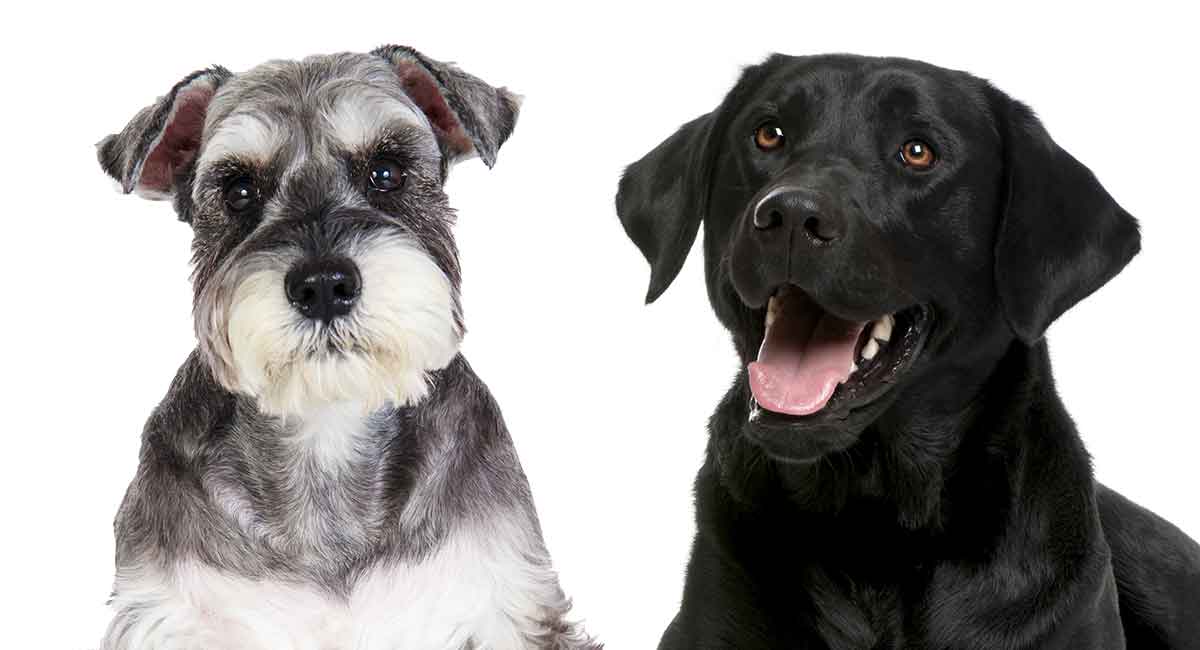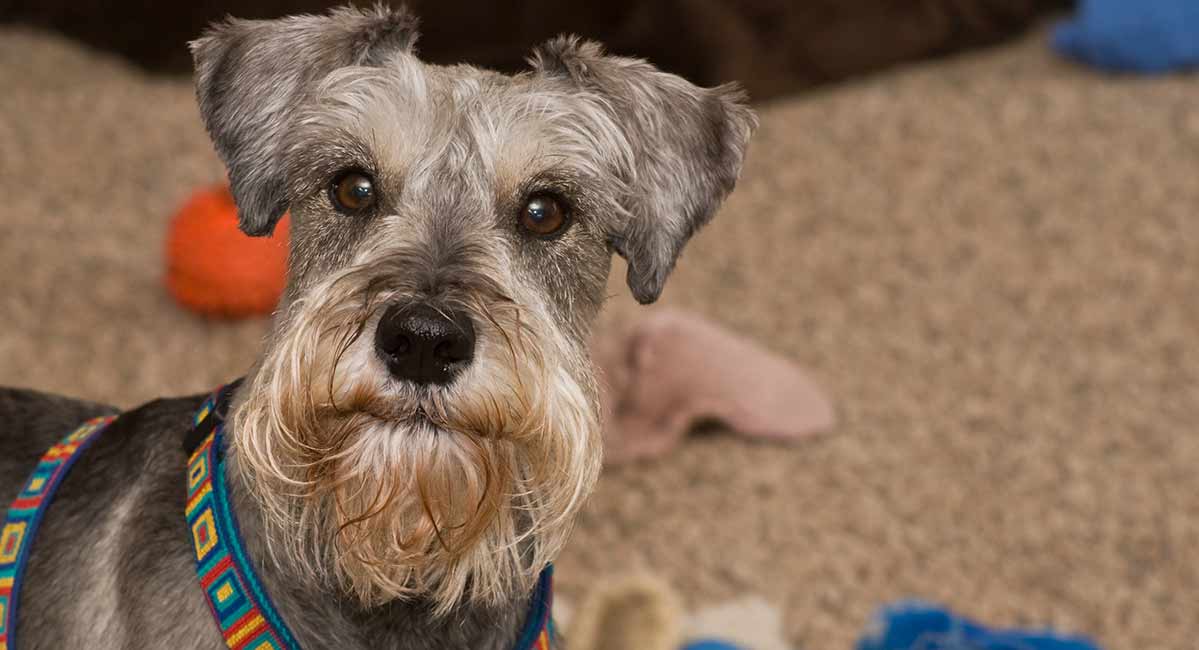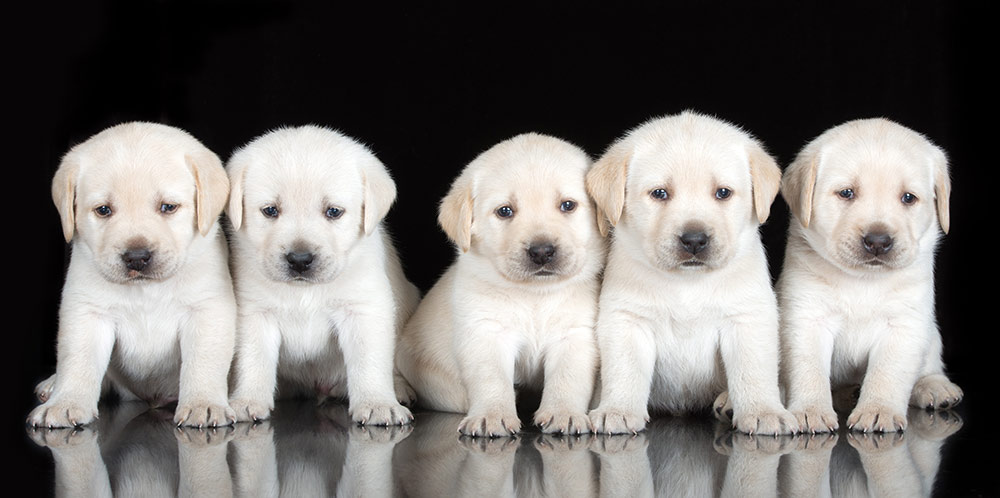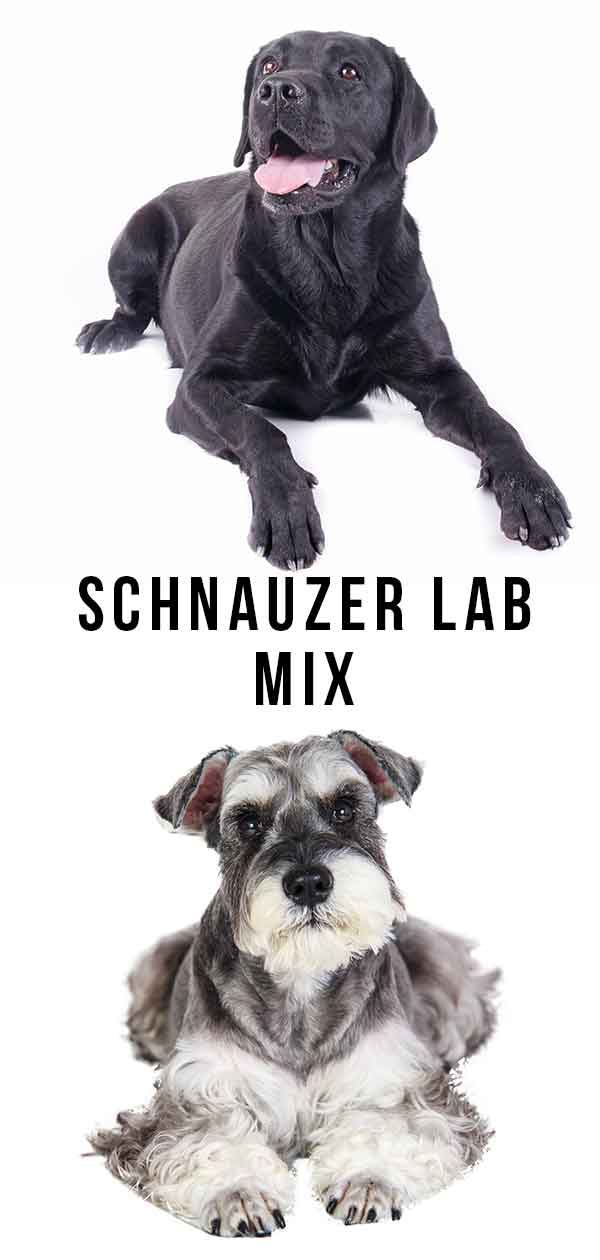
The Schnauzer Lab mix combines the purebred Schnauzer with a pedigree Labrador Retriever to produce a seriously unique litter of puppies. They will have thick, short coats that will usually be black, chocolate or grey in color. Your Schnauzer Lab mix puppy will have large floppy ears and a prominent muzzle, but their build varies from relatively small to quite large depending on whether the Schnauzer parent was a Miniature or Giant variety.
The Schnauzer Lab mix is an intelligent hybrid dog, with a lot of energy to burn. They need daily training sessions and can be destructive if left without company for a few hours. They can also be a little wary of strangers, and very effectively vocal watchdogs around the property.
Contents
- Working histories and origins.
- Typical key characteristics.
- Temperament traits and training.
- Buying healthy puppies.
Where Does the Schnauzer Lab Mix Come From?
We may not know a great deal about the Schnauzer Lab mix itself. But we can definitely learn from looking at the histories of the parent breeds!
The Schnauzer, hailing from Germany, is an intelligent watch and guard dog. This dog was originally bred for ratting, herding, and guarding purposes.
Eventually, three breeds of Schnauzer developed: Miniature, Standard, and Giant. These separate breeds originated in an attempt to specialize the breed.
The Miniature Schnauzer, for example, was bred for ratting. The Standard Schnauzer, though, was created for herding and vermin hunting roles. The Giant Schnauzer was utilized to guard and herd livestock.

The Labrador Retriever is one of the most popular dogs in the world. They are used in therapy, law enforcement, sports and hunting, and as guides for the blind.
They originate from Newfoundland. Originally, they were bred to retrieve fishnets out of the water. They are known to be playful, energetic, and friendly. Because of this, Labs are incredibly popular pets as both purebreds and crossbreeds.

Schnauzer Lab Mix Appearance
A particular puppy might look more like the Schnauzer parents or more like the Labrador parent. Or they could look like an even mix of both. It is just a coin toss.
Generally, though, this dog will weigh between 35 – 70 pounds. They can stand anywhere between 17 – 23 inches at the shoulder. Their size depends on the size of the Schnauzer parent. Labs can only safely breed with Standard and Giant Schnauzers.
This mixed breed is very sturdy and robust, with an athletic build. The cross has one layer or two of medium-length hair.
Schnauzers only come in black. But Labs can come in quite a few colors. The color of this mixed breed will depend mostly on the colors of the parent.

Schnauzer Lab Mix Temperament
Since the Schnauzer Lab mix is a crossbreed, the puppies can inherit any behavioral traits from their parents. While the Labrador doesn’t typically vocalize, the Schnauzer can be quite vocal.
The Labrador Retriever is an amiable dog. But the Schnauzer has guard dog roots and can be wary of strangers.
These dogs are usually tolerant of children. But it is essential to teach the children not to play roughly. The Schnauzer is very sensitive to roughness during play. This dog is not particularly aggressive, however.
These dogs can make good family dogs if you have the time to dedicate to their training. They are generally pretty healthy and are good with children.
The only thing you need to worry about is the possibility of guarding instincts. If they inherit guarding instincts, they can be somewhat vocal and unsure of strangers. Luckily, early socialization and training can prevent many of these problems.
Training Your Schnauzer Lab Mix
Training should begin early for these canines. They are intelligent and usually take to training quite quickly. Labrador Retrievers are very prone to chewing anything they can get their mouth on. Fortunately, this behavior can be trained out to avoid or stop chewing tendencies.
Potty and crate training should begin early. This dog should catch on quickly.
Early socialization is crucial. They can be unsure of strangers, so it is important to be around lots of people early on.
As a highly intelligent dog with an unparalleled sense of smell, Labrador Retrievers can be trained to hunt and track. They can also be used to detect explosive compounds, drugs, and even the early stages of cancer.
Schnauzers are also an intelligent breed. They are aware of their surroundings and will attempt to protect their owners through alerting.
This leads to excessive barking to bring attention to a possible intruder. Fortunately, this behavior can be trained down as a Schnauzer’s bark is very loud.
These dogs have moderate to high exercise requirements. Plan on spending at least an hour exercising them per day.
Schnauzer and Labrador Health
Standard Schnauzers and Labrador Retrievers are prone to hip and elbow dysplasia. They are also prone to a knee problem known as luxating patella.
Labrador Retrievers are the most prone to obesity of all dogs, due to excessive eating habits. Schnauzers are most likely to suffer from urinary stones.
Miniature Schnauzers are prone to portosystemic liver shunts and can suffer from a genetic disease that causes muscles to contract quickly.
This mixed breed can inherit any of these genetic predispositions from their parents. Luckily, there are tests for many of these conditions. An ethical breeder will not breed dogs that are particularly prone to these problems.
Schnauzer Lab Mix Puppies
As with all mix breeds, finding a breeder explicitly dedicated to this particular breed will be difficult, and may require extensive networking. If you do happen to find one, however, it is essential to ensure that the puppy is not coming from a puppy mill. Puppy mills are commonly under scrutiny due to their unethical breeding standards.

Sally says
a beautiful 8 month old puppy looking for a new home came my way 9 years ago. He was a labrador/giant schnauzer mix breed. Having taken him into my life has been one of the best things I have done for me and for him. we are a team now and he is my constant companion.
He is tall, slim, handsome to the extent that people stop, sometimes in their cars, to ask about him when we are out on our walks (can’t claim any credit there). He has the most friendly nature, inherited the labrador shedding coat but that has been a minor issue in the overall benefit of the lovely nature of this beautiful creature.
We have spent many days attending agility classes where it is wonderful to see him following, and sometimes second guessing, what is expected of him over the course.
And he is vocal, very expressive, not barking but howling in a positive way. A very bright, tuned-in dog who ‘gets it’.
I feel so lucky to have him in my life. He is gorgeous……..
Bob says
Smart, friendly and even though they are a little on the stubby side, they are an excellent cross. You won’t find a better behaved and fun companion dog.
Leonardo says
My 50 lb schnauzer lab mix Misty is a sweetheart who loves to play and beg for belly rubs . The most gentle and sweet dog that I’ve ever owned.
Zachary says
Where did you get your dog from? I’ve been searching for someone that has this mix but they are impossible to find.
Diana says
Schnauzers are also salt and pepper and sometimes white.
Robert says
Im hoping someone can help me locate a mixed puppy – half black lab and half standard Schnauzer, to purchase or adopt. I recently lost mine and she was the finest and most intelligent dog i ever had. I jnow i can never find her equal, but i absolutely love this mixed breed
Leo says
I recently lost my lab/standard Schnauzer mix. He was an amazing dog. I’m looking for another. He was 39lbs.
Robert says
I am looking for a Schnauzer/Black Lab mixed breed puppy. Any information as to where i might purchase or rescue one would be greatly appreciated.
Angi Earls says
How much does a half lab half schnauzer puppy cost?
Cheryl Gray says
I found mine in a rescue group which asked for a $200 donation.
Millie Ruck says
I had one, and that is what I want again, please help…I want and have love to give..hook me up if you are lustening….